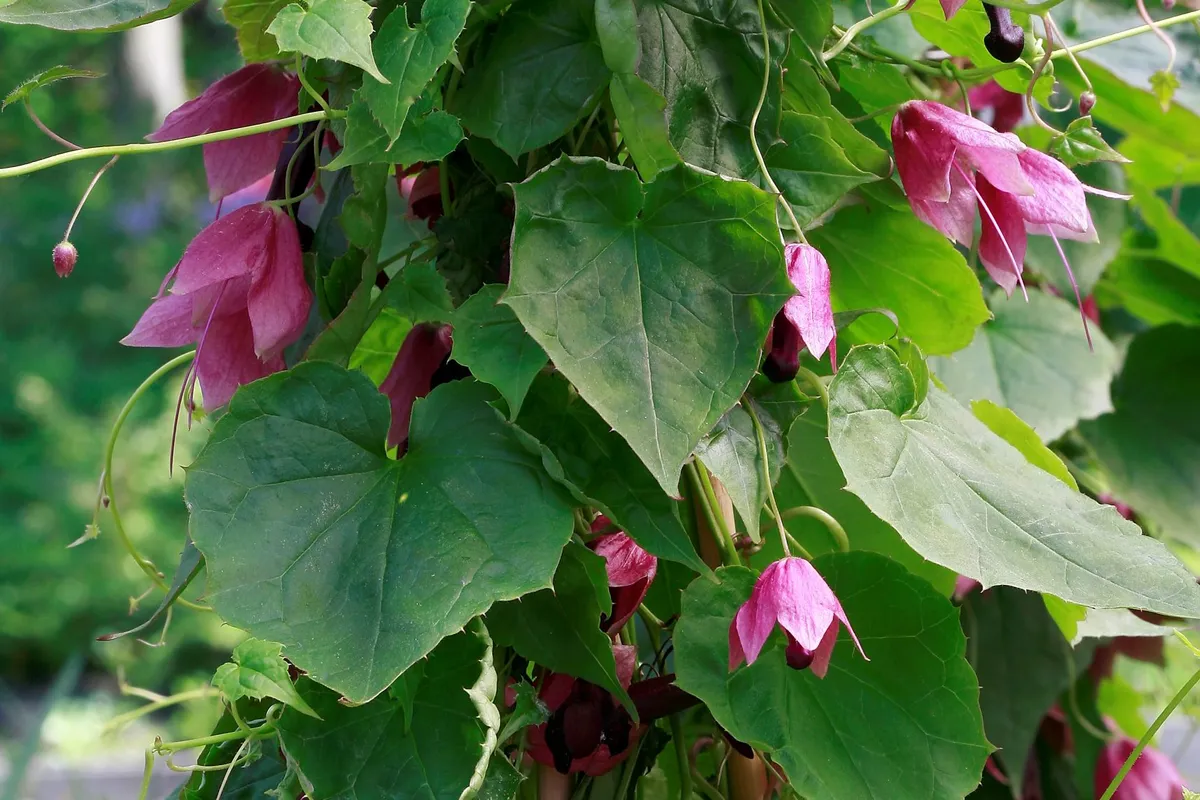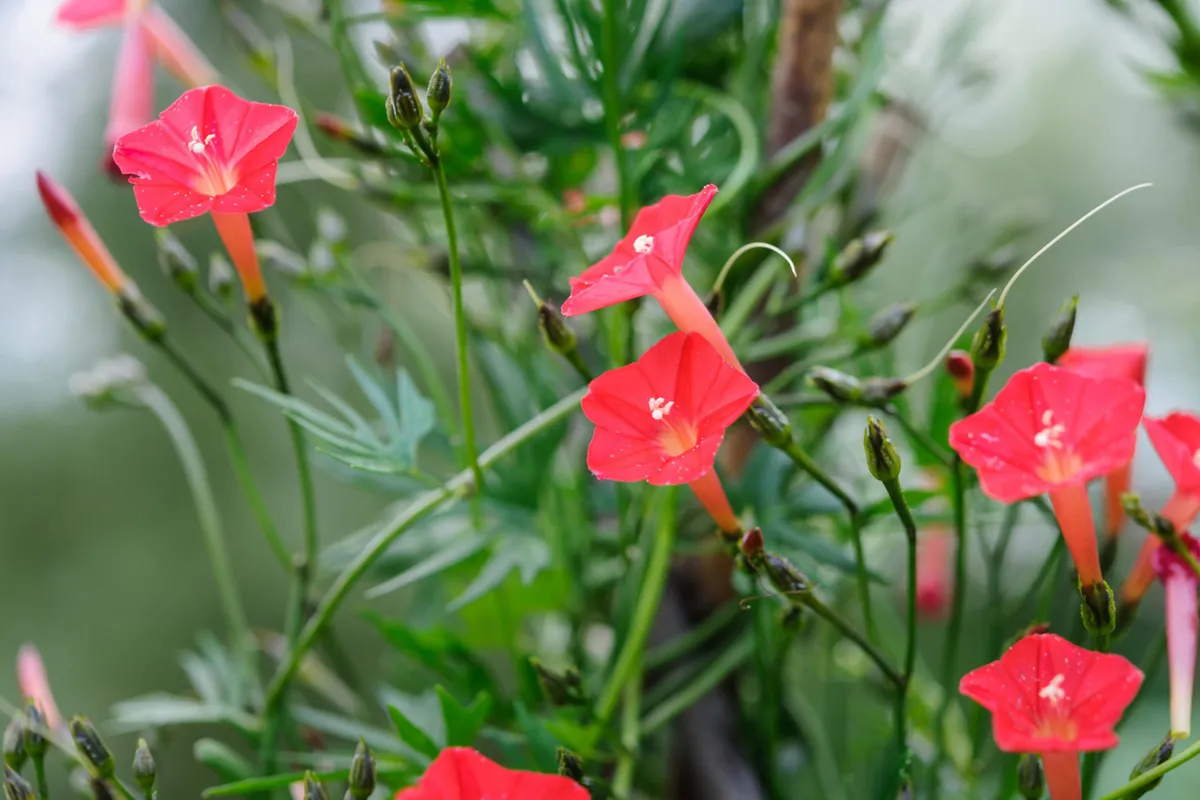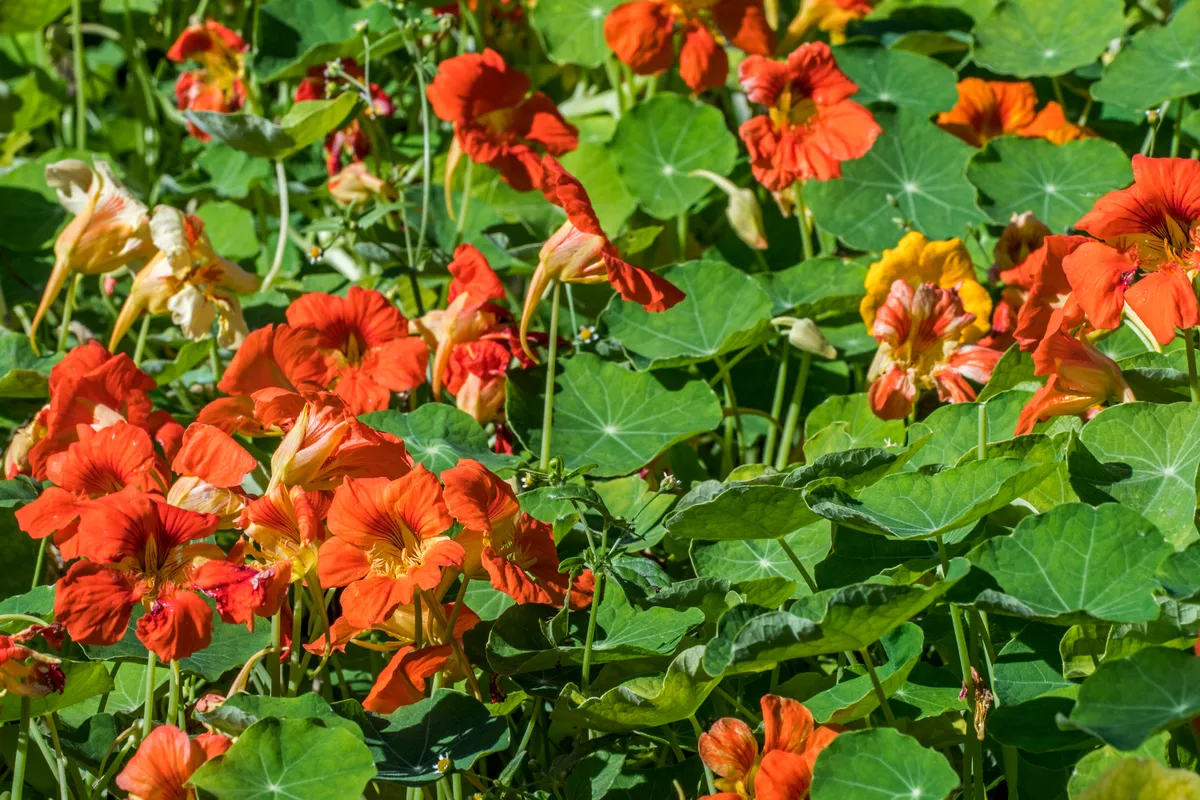While many people focus on garden perennials and climbing plants such as clematis, we should not forget that there are a host of gorgeous annuals out there too, including lots of gorgeous annual climbers.
Annual climbers are often overlooked and yet can bring bursts of colour and interest to brighten the garden in summer. Often from tropical climates, they often have brightly coloured flowers in almost every hue, from ice blue to deep orange. As well as sweet peas, morning glory and black-eyed Susan, there are lots of unusual types to grow, as well as beautiful edibles, such as lablab and runner beans.
You can train annual climbers up fences, temporarily covered with netting, on ornamental pergolas or arches. They can also be encouraged to scramble over shrubs; evergreen shrubs provide the ideal background. They can also be grown up an obelisk or a tripod of canes in containers – most have twining stems or tendrils so need little, other than initial, support.
Their speed of growth also makes annual climbers ideal for quickly covering unsightly areas in a new garden such as a new fence, providing temporary and flexible screening or softening hard surfaces.
Discover more about annual plants and the best to grow
What to grow with annual climbers
Annual climbers make simple standalone displays in pots. Sarah Raven combines Thunbergia alata ‘African Sunset’ with Rhodochiton atrosanguineus and uses Lathyrus chloranthus in vases with dark sweet peas, such as ‘Windsor’. I’ve grown Lathyrus belinensis through dark-leaved Canna ‘Verdi’ to good effect and Lathyrus chloranthus and Ipomoea cultivars, including ‘Star of Yalta’, through an exotic border to enhance the ‘jungle’ effect.
Use the fact the displays last just one season as an opportunity to experiment. For example, try planting Lathyrus tingitanus with its silvery grey foliage, dark buds and end-of-season pods that are marked with a burgundy line along their edge, so that it scrambles over glaucous foliaged conifers, such as Picea pungens ‘Hoopsii’. Or, if you’re growing Rhodochiton atrosanguineus in summer containers, try combining it with tender plants, such as Tibouchina urvilleana, and the fuchshia and lime-coloured leaves of Helichrysum, which will provide stability if you are packing plants into a pot or half barrel. But make sure that whatever climber you select is vigorous enough to thrive in such a competitive environment.
In brief: annual climbers
What Climbers, twiners or scrambling plants for ornamental display.
Origins Tropical and warm temperate zones, worldwide, including the Americas and Mediterranean.
Flowering time Summer until the first frosts.
Size Variable according to natural vigour and micro-climate.
Conditions Most require a sheltered, sunny location in moisture-retentive, free-draining soil.
How to grow annual climbers
- Read the sowing instructions carefully, as some seeds need soaking for 24 hours before sowing.
- Start seeds off on a windowsill or propagator. As all the plants featured here originate in sunnier climates, sow the seed into warmed compost, most at a minimum of 20ºC. Some, including Ipomoea need to be warmer (20-27ºC).
- Before you plant them outside ‘harden off’ by placing them in a sheltered position outdoors during the day and bringing them back under cover at night for around ten days before you plant out.
- Only plant out once the soil has warmed, air temperatures have increased and
there is no danger of frost. It is better to err on the side of caution, as they will soon catch up. - Most grow in moisture-retentive, free-draining soil or in containers of John Innes No.2 compost.
- Avoid adding excessive amounts of well rotted organic or high-nitrogen fertiliser, which encourages lush growth. Start with a general fertiliser, changing to a high-potash fertiliser to encourage flowering, once plants are established.
- Climbers, which are perennials in warmer climates, such as Cobaea scandens, may last for several years if the roots are protected from frost by a wall or mulched with straw or
similar. They can also be lifted and stored over winter in a cool, frost-free place, but they will be more vigorous if you sow seeds annually.
21 of the best annual climbers to grow
Sweet peas

An annual climber in the shape of an elegant, fragile and dainty sweet pea. With grassy foliage and small, beautiful, azure-blue flowers, belies a tough constitution. It is an annual that's tiny and bright blue and doesn't have a strong smell and as it's so tiny, would work well planted near a path or patio. It is tolerant of drought and waterlogging. 90cm. USDA 1a-11.
Rhodochiton atrosanguineus

Often commented upon for its profusion of distinctive, and somewhat vulgar, tubular, black to reddish-purple flowers. This annual climber also has dark stems and heart-shaped, rich-green leaves. 3m. USDA 10a-11. RHS H2.
Ipomoea quamoclit

Handsome native of South America, valued for its attractive, bright-red flowers and deep green, fern-like foliage. An annual climber that is drought tolerant and a favourite of humming birds. There is also a white form. 7m. USDA 11-12.
Tropaeolum majus

There are many forms of this cheerful plant with fresh-green leaves and brightly coloured flowers in shades of red, yellow and orange. Happy to assert its right to roam wherever the gardener allows. 3m. USDA 10a-11
Thunbergia alata ‘African Sunset’
An attractive selection, displaying masses of dusky brick-red to soft-cream flowers with a black centre backed by triangular mid-green leaves. This annual climber comes in a range of colours, from pale yellow to pinks but the dark centre of the flower is always an identifier. The climbing annual is easy to look after, doesn't require pruning although you should watch out for aphids and powdery mildew. For sun or part shade. Height 2.4m. USDA 9a-10b
Mexican viper (Maurandya barclayana)
Also called Mexican viper, and mentioned in one of Charles Darwin's books, The Movements and Habits of Climbing Plants, this annual climber is a pretty, free-flowering herbaceous climber that supports itself with the aid of twining leaf stems. Worth growing for its ivy-shaped leaves and elegant, foxglove-like flowers. And blooms stick around through summer and into autumn. It also is generally pest and disease free. Make sure there's full sun as this climbing annual thrives in light, well-drained soil. 1.5m.
Ipomoea purpurea ‘Star of Yalta’
This herbaceous perennial, grown as an annual, has deep-purple, almost velvet-like flowers with a star of deep pink radiating from the centre of the flower to the tips of the petals. Native to South America, it has rich green foliage in summer and is easy to raise from seed. The annual climber can also be used as ground cover as well as on walls and fences, in a greenhouse or conservatory. Plant in a sheltered spot in chalky, loamy or sandy soil. 1.8m.
Clitoria ternatea
This fast-growing tropical annual climber produces exotically shaped flowers of vivid deep blue. It has many common names including butterfly pea and Darwin pea. In India, it is used in puja rituals as a holy flower. It needs plenty of warmth and sunshine and is at its best during long, hot summers. 2.4m. USDA 10a-11.
Cobaea scandens
The large, greenish-white flowers of this outstanding annual climber species turn dark purple as they age. It flowers best on moist, well-drained soil. 5m. RHS H2, USDA 9a-11.
Lathyrus tingitanus
This annual climber makes up for its lack of fragrance with striking deep rose-purple flowers and a vigorous disposition. Drought tolerant, it likes a warm position in full sun. 1.5m.
Lablab (Lablab purpureus ‘Ruby Moon’)
The richly coloured purple blooms and shining purple pods that follow are complemented by purple-tinted foliage. This annual climber boasts a spread equal to height depending on the growing conditions. 6m. USDA 7a-10b.
Lathyrus odoratus ‘Cupani’
Glorious sweet pea popular for its sweet fragrance and regal magenta and purple flowers, which are freely produced. Pick regularly to prolong the display, which often lasts until first frosts. 3m. RHS H2.
Ipomoea purpurea ‘Grandpa Ott’
Similar in vigour and appearance to ‘Star of Yalta’ but with a rosy, rather than white throat. This annual climber needs a warm, sheltered position to grow. Flowering continues into early autumn. 3m.
Ipomoea lobata ‘Jungle Queen’
The vibrant, multi-coloured tubular flower-spikes of this particularly robust selection (from K Sahin’s in the Netherlands) display a greater colour contrast than the species. An annual climber for sun or shade. 3m.
Eccremocarpus scaber
An open, slender annual climber that produces tubular flowers in shades of red, orange, pink and yellow, from late spring to autumn. The leaves, formed of greyish-green leaflets, create a pleasing texture. 3m. RHS H3, USDA 8a-11.
Runner beans (Phaseolus coccineus ‘Painted Lady’)
Runner beans have long been grown as ornamentals for gazebos and arbours. This pre-1855 cultivar produces tasty, medium-sized pods and the attractive flowers can also be used as a garnish. 3m.
Lathyrus belinensis
The contrasting colour combination of brick-red and yellow makes this a pleasing yet unusual plant that is well worth seeking out. An annual climber that is excellent trailing in containers or as a compact climber. 1.2m.
Caiophora lateritia
A fascinating annual climber from Argentina and Chile with unusual, star-shaped, downward-facing, apricot flowers, twining stems and stinging hairs (only on mature plants). Also known as the twining tingle lily. 3m.
Lathyrus chloranthus
Bright yellow-green and lime flowers ensure that this cheerful native of Asia Minor, will never go unnoticed. Best plants come from autumn sowings. An ideal annual climber for scrambling over a hedge or up twiggy supports. 1.8m or more.
Winter squash (Cucurbita maxima ‘Turk’s Turban’)
These must-have winter squashes can be trained over arches or pergolas to add a sense of playfulness to a garden with their surreal shapes and colours. They are also an invaluable plant for late-season interest. 2m.
Ipomoea alba
Given a warm, sheltered position this Ipomoea offers delicate white, sweetly fragrant, flowers up to 15cm in diameter. These open in the evening and disappear around dawn. 3m. USDA 10a-12.
